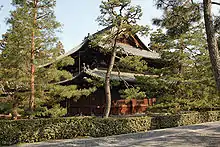Daitoku-ji
Daitoku-ji (大徳寺, the ‘temple of Great Virtue’)[1] is a Buddhist temple, one of fourteen autonomous branches of the Rinzai school of Japanese Zen. It is located in Kita-ku, Kyoto, Japan. The "mountain name" (sangō) by which it is known is Ryūhōzan (龍宝山). The Daitoku-ji temple complex today covers more than 23 hectares (57 acres).[2]
| Daitoku-ji 大徳寺 | |
|---|---|
 Butsuden (Hondo) | |
| Religion | |
| Affiliation | Daitoku-ji Rinzai |
| Location | |
| Location | 53 Murasakino Daitokuji-cho, Kita-ku, Kyoto-shi, 603-8231 |
| Country | Japan |
| Architecture | |
| Founder | Daito Kokushi |
| Completed | 1326 |
| Part of a series on |
| Zen Buddhism |
|---|
 |
History
Daitoku-ji originated as a small monastery founded in 1315 or 1319 by the monk Shūhō Myōchō (宗峰妙超, also pronounced Sōhō Myōchō; 1282–1337), who is known by the title Daitō Kokushi ("National Teacher of the Great Lamp") given by Emperor Go-Daigo.[3] In 1325, the monastery was converted into a supplication hall for the imperial court at the request of the retired Emperor Hanazono. The dedication ceremony for the imperial supplication hall, with its newly added dharma hall and abbot's living quarters, was held in 1326, and this is generally recognized as the true founding of the temple.[2]
Like many other temples in Kyoto during that time, the temple's buildings were destroyed by fire. In 1474, which was when Kyoto was the scene of the Ōnin War, Emperor Go-Tsuchimikado designated Ikkyū Sōjun as the head priest. With the help of merchants of the city of Sakai, Ikkyū contributed significantly to the temple's rehabilitation.[2]
From its earliest days, the temple experienced alternating periods of fortune and decline. This can be attributed to the rivalries and conflicts between Daitoku-ji and other well-known Zen temples, as well as between Daitoku-ji and the political authorities.[4]
Daitoku-ji became particularly important from the sixteenth century, when it was predominantly supported by members of the military establishment, who sponsored the building of subsidiary temples as prayers for their ancestors or in preparation for their own demise.[5] In 1582, Toyotomi Hideyoshi buried his predecessor, Oda Nobunaga, at Daitoku-ji. He also contributed land and built the Sōken-in.
Around this period in history, Daitoku-ji became closely linked to the master of the Japanese tea ceremony, Sen no Rikyū, and consequently to the realm of the Japanese tea ceremony. After the era of Sen no Rikyū, another famous figure in the history of the Japanese tea ceremony who left his mark at this temple was Kobori Enshū.
Buildings
There are several buildings in the complex:
Treasures

Daitoku-ji is home to some works by the 13th-century Chinese artist-monk Mu Qi:
- the acclaimed painting Six Persimmons (housed in Ryūkō-in, the painting is hardly ever put on display)
- the hanging scrolls of Guanyin, Monkeys and Crane (絹本墨画淡彩猿鶴図)[6][7]
Sub-temples
Daitoku-ji operates some twenty-two sub-temples, the most significant being Daisen-in, Jukō-in (聚光院), and Shinjū-an (眞珠庵).[8][9]
- Daiji-in (大慈院)
- Daikō-in (大光院)
- Daisen-in (大仙院)[10]
- Daiyō-an (大用庵)[10]
- Gyokurin-in (玉林院)[10]
- Hōshun-in (芳春院)[10]
- Jukō-in (聚光院)[10]
- Kinryū-in (金龍院)[10]
- Kōrin-in (興臨院)[10]
- Kōtō-in (高桐院)[10]
- Nyoi-an (如意庵)[10]
- Ōbai-in (黄梅院)[10]
- Ryōgen-in (龍源院)[10]
- Ryūkō-in (龍光院)[10]
- Sangen-in (三玄院)[10]
- Shinju-an (真珠庵)[10]
- Shōgen-in (松源院)[10]
- Shōju-in (正受院)
- Shōrin-in (昌林院)
- Sōken-in (総見院)[10]
- Tenzui-ji (天瑞寺)[10]
- Tokuzen-ji (徳禅寺)[10]
- Yōtoku-in (養徳院)
- Zuihō-in (瑞峯院)
Shichidō garan
The garan (compound):
 Hattō
Hattō Sanmon
Sanmon Imperial emissary gate (Chokushi-mon)
Imperial emissary gate (Chokushi-mon) Hondō
Hondō Main alley way
Main alley way
Tatchū
The tatchū (塔中, inner cloisters):
 Garden of the Cross at Zuihō-in
Garden of the Cross at Zuihō-in Dokuza-tei (The Garden of Solitary Sitting), a garden at Zuiho-in
Dokuza-tei (The Garden of Solitary Sitting), a garden at Zuiho-in Go board used by Toyotomi Hideyoshi and Tokugawa Ieyasu at Ryogen-in, Daitoku-ji
Go board used by Toyotomi Hideyoshi and Tokugawa Ieyasu at Ryogen-in, Daitoku-ji

 Kōrin-in
Kōrin-in Kotō-in
Kotō-in
See also
- Goto Zuigan
- Kobori Nanrei Sohaku
- For an explanation of terms concerning Japanese Buddhism, Japanese Buddhist art, and Japanese Buddhist temple architecture, see the Glossary of Japanese Buddhism.
- List of National Treasures of Japan (residences)
- List of National Treasures of Japan (temples)
- List of National Treasures of Japan (ancient documents)
- List of National Treasures of Japan (paintings)
- List of National Treasures of Japan (writings)
References
- "Brief outline to Buddhism: The Land of the Disappearing Buddha (1979)". Course materials to "Asian Religions". Trinity University. Archived from the original on 2015-03-11.
- Kodansha Encyclopedia of Japan, entry "Daitokuji."
- Kodansha Encyclopedia of Japan, entry "Sōhō Myōchō."
- Usui Shiro. Tr., Stephen D. Miller. A Pilgrim's Guide to Forty-six Temples, pp. 84-85. Weatherhill, Inc., 1990. ISBN 0-8348-0211-2.
- Herbert E. Plutschow. Historical Kyoto, p. 141. The Japan Times, Ltd., 1983. ISBN 4-7890-0206-3
- "Database of Registered National Cultural Properties". Agency for Cultural Affairs. Retrieved 7 April 2011.
- "Database of Registered National Cultural Properties". Agency for Cultural Affairs. Retrieved 7 April 2011.
- Dumoulin, Heinrich (2005). Zen Buddhism: A History. World Wisdom, Inc. p. 190. ISBN 0-941532-90-9.
- "Head Temples - Daitoku-ji". Official Site of the Joint Council for Japanese Rinzai and Obaku Zen. Retrieved 2008-01-20.
- Levine, Gregory P.A. (2005). Daitokuji: The Visual Cultures of a Zen Monastery. University of Washington Press. ISBN 0-295-98540-2.
Further reading
Levine, Gregory P.A. (2005). Daitokuji: The Visual Cultures of a Zen Monastery. University of Washington Press. ISBN 0-295-98540-2.
External links
- (in Japanese) Daitoku-ji - halls, sub-temples
- Photos of Daitoku-ji and its sub-temples
| Wikimedia Commons has media related to Daitoku-ji. |
